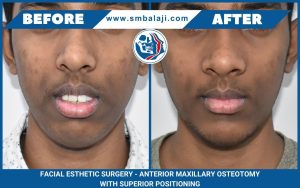Cleft lip and palate deformities in antiquity
Cleft lip and palate were viewed differently by different cultures. Some cultures were more accepting while others outright rejected infants born with these deformities. Chinese doctors in antiquity had developed ingenious ways to conceal cleft defects and many infants born with cleft defects grew up to become fully integrated in adult society. However, in ancient Greece, these children were considered to be from the devil himself and were abandoned in the forest to die.
As scientific knowledge grew gradually with the advent of scientific thought, these deformities came to be better understood and society became more accepting of people born with these deformities.
Patient with surgically corrected unilateral cleft lip and palate
This patient, who is 16 years of age, is from Solapur, India. He was born with unilateral cleft lip and palate. This had resulted in a deformed upper lip and upper jaw. Surgical repair was planned for his condition. He had undergone cleft lip surgery elsewhere when he was 4 months old and cleft palate repair when he was 12 months old. An alveolar cleft reconstruction surgery was then subsequently performed when he was 7-1/2 years old. All the surgeries were performed in his home state of Maharashtra. Cleft palate usually requires orthodontic treatment of permanent teeth.
These surgeries are also performed by board certified plastic surgeons in Western countries, but are performed by oral and maxillofacial surgeons in countries like Japan, China, India, etc. This is one of the most common congenital birth defects seen around the world. Surgical procedures to correct these defects have been developed over the years to give very good esthetic results for the patient.
There is a higher incidence of cleft lip and palate in children born to parents with cleft lip and palate. Ear infections and hearing problems can also be more common in children with cleft deformities.
Speech difficulties faced by the patient all his life
He had always had difficulty conversing clearly with air escaping through his nose while speaking. He had approached an oral surgeon at his hometown for a solution to his problem. The oral surgeon had examined him thoroughly and had explained that he needed a sphincter pharyngoplasty for correction of his problem. He had further explained that this was a procedure that needed to be performed at a specialty cleft lip and palate center and had referred him to our hospital for management of his problem. Our hospital is renowned for cleft lip and palate surgery along with pharyngoplasty surgery in India
Initial presentation at our hospital for treatment
Dr SM Balaji, pharyngoplasty surgery specialist, examined the patient in detail. He conducted a speech assessment test and confirmed that the patient had velopharyngeal insufficiency. The patient’s speech had a nasal twang and there was escape of air to his glottis. Following this, a complete clinical and radiological evaluation was done. It was explained to the patient that correctional surgery yielded best results before 3-1/2 years of age, but since it had been performed only at 7-1/2, the results of the surgery would not be optimal as performed at 3-/1 years.
Velopharyngeal insufficiency (VPI):
Velo refers to the velum or soft palate. It is the part of the roof of the mouth that moves with vocalization of the “ah” sound. Pharyngeal refers to the throat (pharynx). During vocalization of certain sounds, the palate rises to touch the back of the throat and sends the air out of the mouth. In a person with velopharyngeal insufficiency, the soft palate does not contact the throat during speech, which results in escape of air through the nose. This causes a great deal of inconvenience to the patient as their speech is not easily discerned by others.
Treatment planning for correction of the patient’s complaint
It was decided to perform a sphincter pharyngoplasty to correct the patient’s problem of air escaping into the nasal cavity during speech. This surgery is performed under general anesthesia. Flaps of tissue from behind bilateral tonsils are connected across the back of the throat. This narrows down the throat opening, leaving just a small central opening or port in the middle for breathing through the nose. A positive suction test was performed at the conclusion of the surgery to test for proper seal. There was elevation of the soft palate thus confirming successful outcome to the surgery.
Successful outcome for the surgery
Improvement in the patient’s speech was dramatic and immediate after surgery. The patient was very happy with the outcome of the surgery and expressed his complete satisfaction at the results. As for his speech problems, the patient will later be referred for speech therapy for further improvement in his speech.





